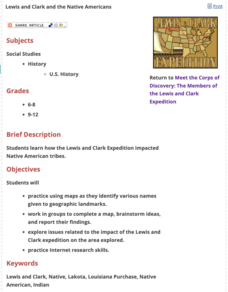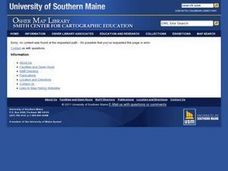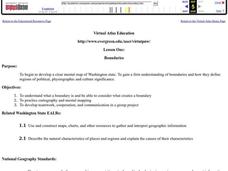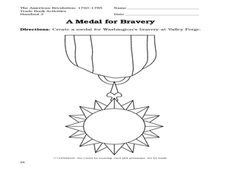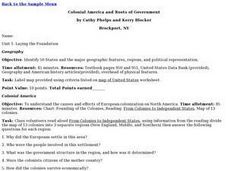Curated OER
The Civil War
Students, examine The Civil War, from a variety of perspectives and assignments. After taking notes, they can choose from creating a front page newspaper article describing the fall of Fort Sumter, discuss the pros and cons of fighting,...
Curated OER
What Is a Primary-Source Document?
Students discover what a primary-source document is, what different types there were back in 1867, and what newer kinds there are today. They play a form of bingo using printed cards that reproduce documents related to Confederation.
Curated OER
Civil War Medicine
Eighth graders discover details about medical care during the American Civil War. In this medical advancements lesson plan, 8th graders participate in classroom station activities that require them to study doctors, amputation, medical...
Curated OER
Overland Trails To The West
Consider the political, physical, and geographical factors that led to and marked the Westward Expansion. Learners will track the various routes developed during the 1800's. They create a first person journal describing what they see,...
Curated OER
Lewis and Clark and the Native Americans
Students practice using maps and identifying landmarks on the Lewis and Clark expedition. They research Lewis and Clark's relationship with the Native Americans and report their findings to the class. They identify the impact of the...
Curated OER
Sam Houston for President...Again
Fourth graders discover the political career of Sam Houston. In this Texas history lesson, 4th graders research primary resources and create a modern-day version of Sam Houston's political campaign of the 1840s.
Curated OER
Charting Neptune's Realm: Profiles
Students identify and describe the importance of nautical profiles in early navigation. They draw a profile of a street or mall and explore the effectiveness of different types of directions.
Curated OER
Boundaries
Learners are introduced to the term of mental mapping. Individually, they develop their own mental map of Washington state and discuss as a class what makes a boundary. They draw their mental map on paper and compare it with their...
Curated OER
Sailing Through History
Students research examples of different types of sailing ships, investigating the vessels as well as the politics, economy, and people at the historical time and place the boat was launched. They create displays for a museum exhibit...
Curated OER
Scavenger Hunt
Learners participate in a scavenger hunt to gather information on their governmental officials. Using the internet, they identify and discuss the various political boundaries to determine who their representative is. They complete a...
Curated OER
No magic borders
Middle schoolers discuss what they have heard about pollution. They explore the purposes and limitations of political boundaries and borders and identify some of the causes and effects of pollution.
Curated OER
Case Studies: Cross-Cultural Comparison
Students examine maps of Lebanon, Vietnam and Nigeria, discuss relationship between ethnicity, land and conflict, review material from case studies, complete comparison chart, and write essays comparing two of the case studies.
Curated OER
Brother Against Brother
Eighth graders read Across Five Aprils and correlate it to a unit on the Civil War. They culminate the unit by writing a a piece of historical fiction in the first person entitled "Brother Against Brother."
Curated OER
BIRTH OF AN EXCEPTIONAL NATION
Students compare the 2 paintings "Washington Crossing the Delaware" and "Prayer at Valley Forge". Look for similarities, differences and information on the painters. Create a political game board using the events from 1776.
Curated OER
Civics and Economics: The Occupation of Japan
Pupils compare the American political and economic systems to the Japanese systems. They interpret maps, tables, charts and political cartoons in analyzing the economic and political issues involved.
Curated OER
Countries of South America
Middle schoolers focus on the geography of the countries of South America. Using a map, they identify the European countries who claimed the South American countries and research the influences they had on South America. To end the...
Curated OER
The ABC's of Apportionment
Students are introduced to the terms of apportionment and redistricting. Using a Census map, they identify the states that had the highest and lowest numbers of change during the past ten years. They examine a map of voting districts and...
Curated OER
Why Kosovo? Why Now?
Students explain the establishment of the modern state of Yugoslavia and the breakup of the country. They examine the human characteristics of the region - ethnic groups, languages, and religions.
Curated OER
A Picture Book of George Washington
Students discuss the character traits of George Washington. In this George Washington instructional activity, students read A Picture Book of George Washington, discuss the book, and complete worksheet activities about Washington's...
Curated OER
1862 MARYLAND CAMPAIGN, AMERICAN CIVIL WAR
Students explain why General Robert E. Lee decided to invade Maryland in September 1862; review the major events of the Maryland Campaign of 1862; describe the major events of the three phases of the Battle of Antietam; and assess the...
Curated OER
How Do You Get To Korea?
Young scholars examine the differences between Korea and the United States. In groups, they identify the physical and political characteristics of Asia and discuss how the geographic features in Korea affect the activities performed...
Curated OER
From Riches to Rice
Tenth graders identify and locate Africa, the United States, the Original 13 colonies, and the region of West Africa on a map. They list examples of culture and African American culture. Students link the culture of West Africa with the...
Curated OER
Life on the Border
Students discuss different types of boundaries. They research the United States/Mexico border and answer questions about their findings. They create collages, posters, or multimedia presentations showcasing various areas of concern...
Curated OER
Colonial America and Roots of Government
Students identify 50 States and the major geographic features, regions, and political representation of each. In connection, they investigate the causes and effects of European colonization on North America. They identify the formation...




